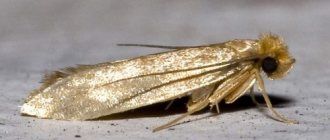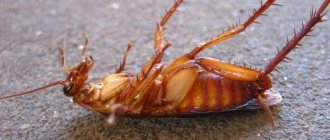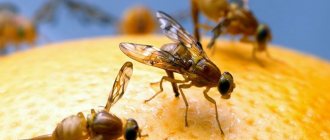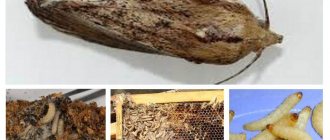Many people prefer to stock up on food for future use: cereals and other groceries do not spoil for a long time and can be safely stored on the shelf. However, if you do not follow food storage rules, you may encounter a number of problems.
The most common problem that often happens with food supplies is the appearance of food moths.
The main enemy of groceries is food moths
Let's see how to deal with it and whether its occurrence can be prevented.
How does food moth appear and what is it?
Visually, the kitchen moth is similar to the clothes moth familiar to many - a small grayish butterfly, sometimes reaching one centimeter in size. The insect feeds on cereals, bread, flour, and cereals, so it tends to be close to food.
Adult moths rarely appear in the kitchen. Most often the larvae appear first. You shouldn’t be surprised at this cycle disruption: you often bring them from the store yourself.
Most often, you bring food moths yourself
There is an opinion that moths can only appear in kitchens where cleaning is neglected. This is far from true. The main source is store-bought cereals and groceries that were improperly stored. They may contain larvae, which over time develop into adults and begin to actively reproduce.
Adult moths can enter the kitchen through a ventilation hole from neighbors. It should be noted that in the butterfly stage the insect causes almost no harm - it lives no more than a week, does not eat anything, but only drinks water. However, during its life cycle, one butterfly can lay up to four hundred eggs, from which larvae hatch.
They are the ones who destroy food supplies, leaving waste products in them. The latter can be dangerous to the health of people, especially those with allergies. That is why it is very important to prevent food moths from appearing in your kitchen, and if they do appear, remove the parasites as quickly as possible.
Reasons for appearance
Of course, the parasite does not appear out of nowhere. Where do moths come from?
The most common reason for the appearance is contaminated products brought from the store.
Most of the larvae are in bulk products: flour, cereals, dried fruits, nuts, herbs.
Therefore, if you want to avoid this problem, purchase such products from trusted stores and carefully check the tightness of the packaging.
Another source of infection is neighbors. If they have this problem, it is likely that some of the moths will move to you in search of a more varied diet.
Moths may fly into the window - however, this case is considered quite rare, so there is no need to worry.
Signs of kitchen moth infestation
Having figured out how moths appear in the kitchen, we move on to the next stage - getting rid of them. It is important to understand that the sooner you begin the process of “treating” the kitchen from food moths, the less effort you will have to put in.
Carefully examine all the cereals you bring - there may be an uninvited guest in them
By these signs you can determine that the room is already infested with parasites:
- The most obvious sign is adults. If you see at least one butterfly, we recommend that you immediately attend to the issue of eliminating parasites.
- Musty smell on food shelves. Dead larvae and waste products decompose and emit an unpleasant, subtle aroma.
- The presence of cobwebs, darkish or gray cocoons in cereals and grains. This means that the product has already become a nesting ground for larvae.
- The most unpleasant sign of infection is the presence of yellow worms and moth larvae. They can crawl around in food or crawl along the walls of the cabinet.
If you are not sure whether you have moths in your kitchen, use our life hack. Turn on a small flashlight in the kitchen at night and wait five to ten minutes. Adult butterflies always flock to the light.
If you encounter such phenomena, you must urgently begin to eliminate the parasites!
What harm does
Moth in the cereal.
Unlike ordinary butterflies, which breed in the summer, the food species in an apartment can breed all year round. This is one of the reasons why food moths are dangerous and why they need to be removed as quickly as possible.
It usually starts in products that have expired or when sanitary rules are violated. She wanders around the kitchen cabinet and eats everything that comes in her way. The pest especially loves cereal products, pasta, flour, nuts, dried fruits, and candies. All products that end up in cabinets contaminated with moths and their larvae will be spoiled.
You may wonder if food moths eat clothes. The answer is clear: it is not dangerous for fur and wool products.
How to get rid of it at home
Many companies now offer services for quickly removing “unwanted guests” from your kitchen. However, we believe that it is not worth going there when it comes to food moths.
Firstly, they often use aggressive chemicals that are undesirable to come into contact with products and work surfaces. Secondly, their services are quite expensive. And most importantly, it’s not difficult to get rid of moths on your own; you just need to be diligent and carefully follow our step-by-step recommendations.
You need to check all stocks
First of all, it is necessary to conduct a thorough inspection of the premises. First, inspect your kitchen cabinets and their contents. Check all containers with cereals, flour, spices and other groceries. You should be especially careful if you store food in plastic bags.
By the way, hungry larvae can easily chew through bags and even plastic containers, so if the package is closed, this does not mean that it is not infected.
Check the tops of cabinets, baseboards, cornices, and chandeliers. Adults may be hiding there and must also be destroyed.
Don’t forget about ventilation: moths can hide there
Next, you should proceed directly to cleansing the kitchen of parasites. Unfortunately, we cannot offer a large number of options for how to get rid of food moth larvae - the most effective method is to throw away all the food. If you don't want to act so radically, follow the following instructions.
First, throw away those foods that are obviously contaminated. If you are not sure about something, remember that it is better to be on the safe side than to have to deal with multiplied moths again later. Therefore, do not skimp on cereals that seem suspicious to you. Throw away anything that causes even the slightest suspicion of contamination.
Wash all the jars and wipe them with vinegar. We recommend vacuuming the shelves with a vacuum cleaner without an attachment. The process is quite tedious, but you are almost guaranteed to attract all the parasites.
Then wash the shelves and cabinet walls. You can use vinegar, a solution of laundry soap, or special antiparasitic agents - raid or raptor, for example. However, we must warn you about the latter: they should not come into contact with food, so it is better to look for another option.
Don’t neglect professional products: they are very effective
In this way, treat all surfaces where larvae may be located.
All that remains is to defeat the adult moths. Catching them manually is ineffective - the sneaker method of fighting parasites has long been outdated. It is better to use a special trap.
This could be the familiar adhesive tape that is used in the summer as a fly trap. A more modern option is a pheromone trap. It emits a pleasant aroma for moths, which attracts them. Then you just need to throw away such a trap. The trap will neutralize the males, and the females will not be able to reproduce and will soon die out - remember, the life cycle of a moth is only one week.
A trap is a reliable way to catch adults
Just in case, vacuum the ceiling and cornices - most females are very slow and this way you can significantly reduce their number.
Varieties of moths
There are several types of home moth; each group gives preference to its favorite product, but does not neglect others. There are eight main types of household pests.
- Flour moth. The firefly is small in size with beige colored wings. This type of insect reproduces faster than its counterparts. If you notice small cocoons in the flour, it means that the parasite has entered the house. Sift the flour through a sieve, then cook in the oven for at least half an hour. Store flour in an airtight container.
- Grain moth. A firefly with narrow wings of a yellowish tint, the color is similar to the color of grain so that it can blend in with it. She focuses on buckwheat, rice, rye and wheat. The safest way to get rid of the parasite is to use special traps.
- Mill moth. A butterfly up to 1.5 cm in size, with dark gray dotted wings. This type of moth is rarely found in apartments; they are usually found in mills.
- Potato moth. A small, inconspicuous moth with gray wings and long antennae. The larvae like to attack old potatoes, as their tubers are softer. They bite into fruits, causing rotting. You can fight potato moth by adjusting the storage temperature of root crops below 0°C. For a better effect, tubers can be treated with biological preparations.
- Onion moth. Wingspan up to 17 mm. The body and fore wings are brown, the hind wings are gray with fringe. The larvae eat the onion, causing the vegetable to rot.
- Cereal moth. A butterfly with silver-gray wings, the span of which reaches 14 mm. The larva destroys cereals and seeds, gluing the grains into pellets using a web. Its appearance indicates that the grain has already been stored in the warehouse.
- Chocolate moth. Eats coffee, cocoa beans, chocolate and other “confectionery”. She makes passages in chocolate products, leaving behind grains of feces. The size of the worms does not exceed 0.5 cm, so they fit into the smallest holes in the wrapper.
- Fruit moth. The gray butterfly, approximately 10 mm in size, is nocturnal. Moths grow in dried fruits, fruits and mushrooms. Its larvae break through canals, turning the fruits into dust. The insect does not disdain other products, so you can see moths in walnuts, almonds or hazelnuts.
In the apartment, food moths eat all grocery products. Therefore, first check for caterpillars:
- cereals;
- pasta;
- beans;
- peas;
- flour;
- sugar;
- candies;
- nuts and dried fruits;
- bread;
- cookie;
- spices;
- tea;
- coffee;
- cocoa;
- animal feed.
Different types of parasites can easily live next to each other. Therefore, when you find a moth, carefully check not only your food, but also your wardrobe.
Saving food: measures to combat larvae
As we already said, the most effective way to kill the larvae is to throw away all the food. However, if you do not agree to such sacrifices, then it is necessary to secure the remaining supplies.
You can do this in several ways:
- Hand-sort the grains and sift the flour and salt through a sieve.
- Place the food in the freezer for at least three to four days.
- An alternative way is to bake the food in the oven at 60 degrees for 40 minutes. However, this method is not suitable for all types of groceries. For example, the flour will darken or spoil. Semolina will also lose its quality, so this method is recommended only for whole grain cereals.
- If you have a microwave, pour the cereal into a bowl and microwave for 2-3 minutes at maximum power. Like the previous method, this one is only suitable for whole grain cereals.
These methods are very effective, but require careful preliminary mechanical processing of cereals and other products. You need to pick out all the larvae and eggs, otherwise they will remain in the food, even if frozen or baked.
All inventory must be checked manually
In our opinion, not the most appetizing seasoning. Therefore, we advise you to throw away your groceries anyway - cereals, pasta and flour are not that expensive, and the larvae, even if thermally processed, can cause an allergic attack.
Preventive measures
After you have completed cleaning the kitchen from food moths, you need to ensure that they no longer enter your home.
To do this, use our tips:
- Buy only high quality groceries from good stores. In markets and small retail outlets, food storage conditions are often violated, which means there may be favorable conditions for moth colonies.
- Immediately pour all products into sealed iron, ceramic, glass, tin jars and close tightly.
- Even the cleanest-looking cereal is best washed and calcined or frozen before putting it in the cupboard. It is worth sifting the flour - this way you will avoid the risk of infection with almost 100% probability.
- Use one of the folk recipes for moths given in the next section.
- Don’t try to buy food for future use. It is better to purchase cereals, flour and pasta as needed. Ideally, the packaging should not sit in your closet for more than a couple of months.
- Carefully monitor the expiration date of your groceries. If something is no longer suitable for use, do not regret it, but throw it away immediately.
- It is better to store food for cats and dogs, grain for birds, not in the kitchen or, at least, in a cabinet separate from the grocery store.
- Wipe down shelves regularly with a mild soap or vinegar solution.
- Conduct an inspection once a month to promptly identify potential sources of infestation.
- Show your neighbors this article to avoid moth infestations from them.
If you are not lazy in following these recommendations, your kitchen will be almost one hundred percent protected from the possibility of moth infestation.
Kinds
Depending on certain food preferences, as well as the characteristics of localization, life activity, and color, food moths are divided into several main subspecies, the main ones of which are the following:
- Flour moth or moth. This is the most unpretentious type of insect, common in ordinary apartments.
- Kitchen moth or cocoa moth. This species is especially often confused with the clothes one, which is due to the specific coloring - the wings of such insects have a light yellow tint.
- Fruit moth. As the name suggests, the larvae of this insect prefer to eat dried fruits and fresh fruits. This butterfly is also a garden pest.
- Barn fire. This insect is often found in large granaries. It is especially difficult to destroy.
All types of food moths share food preferences, namely: their food sources are groceries, flour, sugar, cookies, dried bread, and more.
The best folk remedies for food moths
First of all, it should be noted that natural remedies against food moths only work as a preventive measure - therefore they must be used after cleaning.
Folk remedies can be excellent helpers in getting rid of moths
However, many recipes are well proven as proactive methods of combating parasites, so it would not hurt to use one of the methods - this way you are guaranteed to avoid the appearance of moths in your kitchen.
So, what to put in the cabinet against food moths:
- Vinegar. As we already wrote, vinegar is effective in removing small eggs and larvae. However, it can also be an excellent preventive measure. A weak vinegar solution leaves a smell that is practically not felt by humans, but it repels moths.
- Citrus zest. Place dried lemon or orange peels in your kitchen cabinets. They will effectively scare away flying parasites, and in addition will fill the kitchen with a pleasant, subtle aroma.
- Ammonia is no less effective. First, check if your household is allergic to it.
- Lavender. No less effective than citrus fruits, but has one side effect. The smell of lavender flowers is highly persistent, so it is not recommended to use it in cabinets with food products that are not hermetically sealed - they will smell of its aroma. But if you store groceries in jars, glass or iron, this problem will not arise.
- You can put a clove of unpeeled garlic directly into the cereal. It will not change the taste and smell of food, but for moth larvae it will act as a strong irritant.
- The bay leaf plays approximately the same role. It is important to make sure that the laurel is fresh and has not lost its smell - otherwise the technique will not work. Lay out the bay leaves in the cupboard and add one at a time to the jars. The moth will not dare to poke its nose into such a fragrant place.
- Moths are repelled by the smells of cloves, geranium, wild rosemary, tansy, fir, rosemary, and basil. You can put dried flowers or twigs in the closet, or use aromatic oils. By the way, fresh geranium flowers, along with moths, repel many insects, including mosquitoes - we recommend planting a couple of pots on the windowsill.
- You can put fresh young walnut sheets in your cupboards. An unpleasant smell for moths will scare them away. True, this will not work with the nuts themselves - the kernels, on the contrary, can attract these parasites.
- If the smell of camphor does not bother you, lubricate the walls of the cabinet with camphor oil.
- Moths cannot tolerate the smell of tobacco. This does not mean that we encourage you to smoke in the kitchen - although, in theory, the method is not without effectiveness. Crumble a couple of cigarettes on the shelves or just leave an open pack in the closet. Reviews on the Internet say that this is enough to even scare away the moths that have already settled in your home.
- Sometimes there is advice to spray the inside of the cabinets with perfume or air freshener - moths do not tolerate strong odors. However, we do not recommend doing this: try to minimize the use of chemicals in your kitchen. They can be harmful to health.
Choose a method of protection against moths that is comfortable for you, and parasites will no longer bother you!











